Investigation of Ion Release and Antibacterial Properties of TiN-Cu-Nanocoated Nitinol Archwires
Abstract
:1. Introduction
2. Materials and Methods
2.1. Deposition of the Films
2.2. Physicochemical Characterization of the Films
2.3. Inductively Coupled Plasma Optical Emission Spectroscopy
2.4. MTT Cytotoxicity Assay
2.5. Bacterial Adhesion and Biofilm Formation
2.6. Statistical Analysis
3. Results
3.1. FESEM
3.2. EDS
3.3. XRD
3.4. FTIR
3.5. Ion Release Measurements
3.6. MTT Analysis
3.7. Antibacterial Analysis
4. Discussion
5. Conclusions
Author Contributions
Funding
Institutional Review Board Statement
Informed Consent Statement
Data Availability Statement
Conflicts of Interest
References
- American Dental Association (ADA). Oral Health and Well-Being in the United States. Available online: https://www.ada.org/resources/research/health-policy-institute/coverage-access-outcomes/oral-health-and-well-being (accessed on 9 June 2023).
- Nespoli, A.; Passaretti, F.; Szentmiklósi, L.; Maróti, B.; Placidi, E.; Cassetta, M.; Yada, R.Y.; Farrar, D.H.; Tian, K.V. Biomedical NiTi and β-Ti Alloys: From Composition, Microstructure and Thermo-Mechanics to Application. Metals 2022, 12, 406. [Google Scholar] [CrossRef]
- Papadopoulou, K.; Eliades, T. Microbiologically-influenced corrosion of orthodontic alloys: A review of proposed mechanisms and effects. Aust. Orthod. J. 2009, 25, 63–75. [Google Scholar] [PubMed]
- Rincic Mlinaric, M.; Karlovic, S.; Ciganj, Z.; Pop Acev, D.; Pavlic, A.; Spalj, S. Oral antiseptics and nickel titanium alloys: Mechanical and chemical effect of interaction. Odontology 2019, 107, 150–157. [Google Scholar] [CrossRef] [PubMed]
- Kulkarni, P.; Agrawal, S.; Bansal, A.; Jain, A.; Tiwari, U.; Anand, A. Assessment of nickel release from various dental appliances used routinely in pediatric dentistry. Indian J. Dent. 2016, 7, 81–85. [Google Scholar] [CrossRef]
- Gursoy, U.K.; Sokucu, O.; Uitto, V.J.; Aydin, A.; Demirer, S.; Toker, H.; Erdem, O.; Sayalet, A. The role of nickel accumulation and epithelial cell proliferation in orthodontic treatment- induced gingival overgrowth. Eur. J. Orthod. 2007, 29, 555–558. [Google Scholar] [CrossRef]
- Amauri, J.P.; Hwang, G.; Koo, H. Dynamics of bacterial population growth in biofilms resemble spatial and structural aspects of urbanization. Nat. Commun. 2020, 11, 1354. [Google Scholar]
- Lucchese, A.; Gherlone, E. Prevalence of white-spot lesions before and during orthodontic treatment with fixed appliances. Eur. J. Orthod. 2012, 35, 664–668. [Google Scholar] [CrossRef]
- Morán-Martínez, J.; Monreal-de Luna, K.D.; Betancourt-Martínez, N.D.; Carranza-Rosales, P.; Contreras-Martínez, J.G.; López-Meza, M.C.; Rodríguez-Villarreal, O. Genotoxicity in oral epithelial cells in children caused by nickel in metal crowns. Genet. Mol. Res. 2013, 12, 3178–3185. [Google Scholar] [CrossRef]
- Alp, G.; Çakmak, G.; Sert, M.; Burgaz, Y. Corrosion potential in artificial saliva and possible genotoxic and cytotoxic damage in buccal epithelial cells of patients who underwent Ni-Cr based porcelain-fused-to-metal fixed dental prostheses. Mutat. Res./Genet. Toxicol. Environ. Mutagen. 2018, 827, 19–26. [Google Scholar]
- Sfondrini, M.F.; Cacciafiesta, V.; Maffia, E.; Scribante, A.; Alberti, G.; Biesuz, R.; Klersy, C. Nickel release form new conventional stainless steel, recycled, and nickel free orthodontic brackets: A in vitro study. Am. J. Orthod. Dentofac. Orthop. 2009, 137, 809–815. [Google Scholar] [CrossRef]
- Biesiekierski, A.; Wang, J.; Gepreel, M.A.; Wen, C. A newlook at biomedical Ti-based shape memory alloy. Acta Biomater. 2012, 8, 1661–1669. [Google Scholar]
- Das, K.K.; Reddy, R.; Bagoji, I.B.; Das, S.; Bagali, S.; Mullur, L.; Khodnapur, J.P.; Biradar, M.S. Primary concept of nickel toxicity—An overview. J. Basic Clin. Physiol. Pharmacol. 2018, 30, 141–152. [Google Scholar]
- Ikeda, D.; Ogawa, M.; Hara, Y.; Nishimura, Y.; Odusanya, O.; Azuma, K.; Satoshi Matsuda, S.; Yatsuzuka, M.; Murakami, A. Effect of nitrogen plasma-based ion implantation on joint prosthetic material. Surf. Coat. Technol. 2002, 156, 301–305. [Google Scholar]
- Weng, K.; Chen, Y.; Lin, T.; Wang, D. Characterization of Titanium Nitride Coatings Deposited by Metal Plasma Ion Pre-Implantation and Cathodic Arc Evaporation. J. Nannosci. Nanotechnol. 2009, 9, 1127–1132. [Google Scholar] [CrossRef] [PubMed]
- Gill, P.; Musaramthota, V.; Munroe, N.; Datye, A.; Dua, R.; Haider, W.; McGoron, A.; Rokicki, R. Surface modification of Ni–Ti alloys for stent application after magnetoelectropolishing. Mater. Sci. Eng. C Mater. Biol. Appl. 2015, 50, 37–44. [Google Scholar] [PubMed]
- Wang, N.; Yu, J.; Yan, J.; Hua, F. Recent advances in antibacterial coatings for orthodontic appliances. Front. Bioeng. Biotechnol. 2023, 11, 1093926. [Google Scholar] [PubMed]
- Bącela, J.; Łabowska, M.B.; Detyna, J.; Zięty, A.; Michalak, I. Functional Coatings for Orthodontic Archwires—A Review. Materials 2020, 13, 3257. [Google Scholar] [CrossRef]
- Godoy-Gallardo, M.; Eckhard, U.; Delgado, L.M.; de Roo Puente, Y.J.D.; Hoyos-Nogués, M.; Gil, F.J.; Perez, R.A. Antibacterial approaches in tissue engineering using metal ions and nanoparticles: From mechanisms to applications. Bioact. Mater. 2021, 6, 4470–4490. [Google Scholar]
- Ruiz, L.M.; Libedinsky, A.; Elorza, A.A. Role of Copper on Mitochondrial Function and Metabolism. Front. Mol. Biosci. 2021, 8, 711227. [Google Scholar]
- Chen, Z.; Meng, H.; Xing, G.; Chen, C.; Zhao, Y.; Jia, G.; Wang, T.; Yuan, H.; Ye, C.; Zhao, F.; et al. Acute toxicological effects of copper nanoparticles in vivo. Toxicol. Lett. 2006, 163, 109–120. [Google Scholar] [CrossRef] [PubMed]
- Tudose, I.V.; Comanescu, F.; Pascariu, P.; Bucur, S.; Rusen, L.; Iacomi, F.; Koudoumas, E.; Suchea, M. Chapter 2—Chemical and physical methods for multifunctional nanostructured interface fabrication. In Micro and Nano Technologies, Functional Nanostructured Interfaces for Environmental and Biomedical Applications; Dinca, V., Suchea, M.P., Eds.; Elsevier: Amsterdam, The Netherlands, 2019; pp. 15–26. [Google Scholar]
- ISO 10993-5:2009; Biological Evaluation of Medical Devices—Part 5: Tests for In Vitro Cytotoxicity. ISO: Geneva, Switzerland, 2009.
- Cetenovic, B.; Prokic, B.; Vasilijic, S.; Dojcinovic, B.; Magic, M.; Jokanovic, V.; Markovic, D. Biocompatibility investigation of new endodontic materials based on nanosynthesized calcium silicates combined with different radiopacifiers. J. Endod. 2017, 43, 425–432. [Google Scholar] [PubMed]
- Özyildiz, F.; Uzel, A.; Hazar, A.S.; Güden, M.; Olmez, S.; Aras, I.; Karaboz, I. Photocatalytic antimicrobial effect of TiO2 anatase thin-film–coated orthodontic arch wires on 3 oral pathogens. Turk. J. Biol. 2014, 38, 289–295. [Google Scholar] [CrossRef]
- Nickel—Registration Dossier—ECHA. Available online: https://european-union.europa.eu/select-language?destination=/node/1 (accessed on 9 June 2023).
- Sugisawa, H.; Kitaura, H.; Ueda, K.; Kimura, K.; Ishida, M.; Ochi, Y.; Kishikawa, A.; Ogawa, S.; Takano-Yamamoto, T. Corrosion resistance and mechanical properties of titanium nitride plating on orthodontic wires. Dent. Mater. J. 2018, 37, 286–292. [Google Scholar] [CrossRef]
- Ito, A.; Kitaura, H.; Sugisawa, H.; Noguchi, T.; Ohori, F.; Mizoguchi, I. Titanium nitride plating reduces nickel ion release from orthodontic wire. Appl. Sci. 2021, 11, 9745. [Google Scholar] [CrossRef]
- Bocchetta, P.; Chen, L.Y.; Tardelli, J.D.C.; Reis, A.C.D.; Almeraya-Calderón, F.; Leo, P. Passive Layers and Corrosion Resistance of Biomedical Ti-6Al-4V and β-Ti Alloys. Coatings 2021, 11, 487. [Google Scholar] [CrossRef]
- Hosoki, M.; Nishigawa, K.; Miyamoto, Y.; Ohe, G.; Matsuka, Y. Allergic contact dermatitis caused by titanium screws and dental implants. J. Prosthodont. Res. 2016, 60, 213–219. [Google Scholar] [PubMed]
- Azizi, A.; Jamilian, A.; Nucci, F.; Kamali, Z.; Hosseinikhoo, N.; Perillo, L. Release of metal ions from round and rectangular NiTi wires. Prog. Orthod. 2016, 17, 10. [Google Scholar] [PubMed]
- Taylor, A.A.; Tsuji, J.S.; Garry, M.R.; McArdle, M.E.; Goodfellow, W.L., Jr.; Adams, W.J.; Menzie, C.A. Critical Review of Exposure and Effects: Implications for Setting Regulatory Health Criteria for Ingested Copper. Environ. Manag. 2020, 65, 131–159. [Google Scholar]
- Jenko, M.; Godec, M.; Kocijan, A.; Rudolf, R.; Dolinar, D.; Ovsenik, M.; Gorensek, M.; Zaplotnik, R.; Mozetic, M. A new route to biocompatible Nitinol based on a rapid treatment with H2/O2 gaseous plasma. Appl. Surf. Sci. 2019, 473, 976–984. [Google Scholar]
- Rongo, R.; Valletta, R.; Bucci, R.; Rivieccio, V.; Galeotti, A.; Michelotti, A.; D’Antò, V. In vitro biocompatibility of nickel-titanium esthetic orthodontic archwires. Angle Orthod. 2016, 86, 789–795. [Google Scholar]
- Laird, C.; Xu, X.; Yu, Q.; Armbruster, P.; Ballard, R. Nickel and chromium ion release from coated and uncoated orthodontic archwires under different pH levels and exposure times. J. Oral Biosci. 2021, 63, 450–454. [Google Scholar] [CrossRef] [PubMed]
- Ren, Y.; Jongsma, M.A.; Mei, L.; Van Der Mei, H.C.; Busscher, H.J. Orthodontic treatment with fixed appliances and biofilm formation—A potential public health threat? Clin. Oral. Investig. 2014, 18, 1711–1718. [Google Scholar] [PubMed]
- Kolenbrander, P.E. Oral microbial communities: Biofilms, interactions, and genetic systems. Annu. Rev. Microbiol. 2000, 54, 413–437. [Google Scholar]
- Teixeira, L.P.; Gontijo, L.C.; Franco Junior, A.R.; Pereira, M.F.; Schuenck, R.P.; Malacarne-Zanon, J. Evaluation of antimicrobial potential and surface morphology in thin films of titanium nitride and calcium phosphate on orthodontic brackets. Am. J. Orthod. Dentofac. Orthop. 2021, 160, 209–214. [Google Scholar]
- Jabbari, Y.S.A.; Fehrman, J.; Barnes, A.C.; Zapf, A.M.; Zinelis, S.; Berzins, D.W. Titanium nitride and nitrogen ion implanted coated dental materials. Coatings 2012, 2, 160–178. [Google Scholar] [CrossRef]
- Laha, D.; Pramanik, A.; Laskar, A.; Jana, M.; Pramanik, P.; Karmakar, P. Shape-dependent bactericidal activity of copper oxide nanoparticle mediated by DNA and membrane damage. Mater. Res. Bull. 2014, 59, 185–191. [Google Scholar] [CrossRef]
- Majumdar, T.D.; Singh, M.; Thapa, M.; Dutta, M.; Mukherjee, A.; Ghosh, C.K. Size-dependent antibacterial activity of copper nanoparticles against Xanthomonas oryzae pv. Oryzae—A synthetic and mechanistic approach. Colloid Interface Sci. Commun. 2019, 32, 100190. [Google Scholar] [CrossRef]
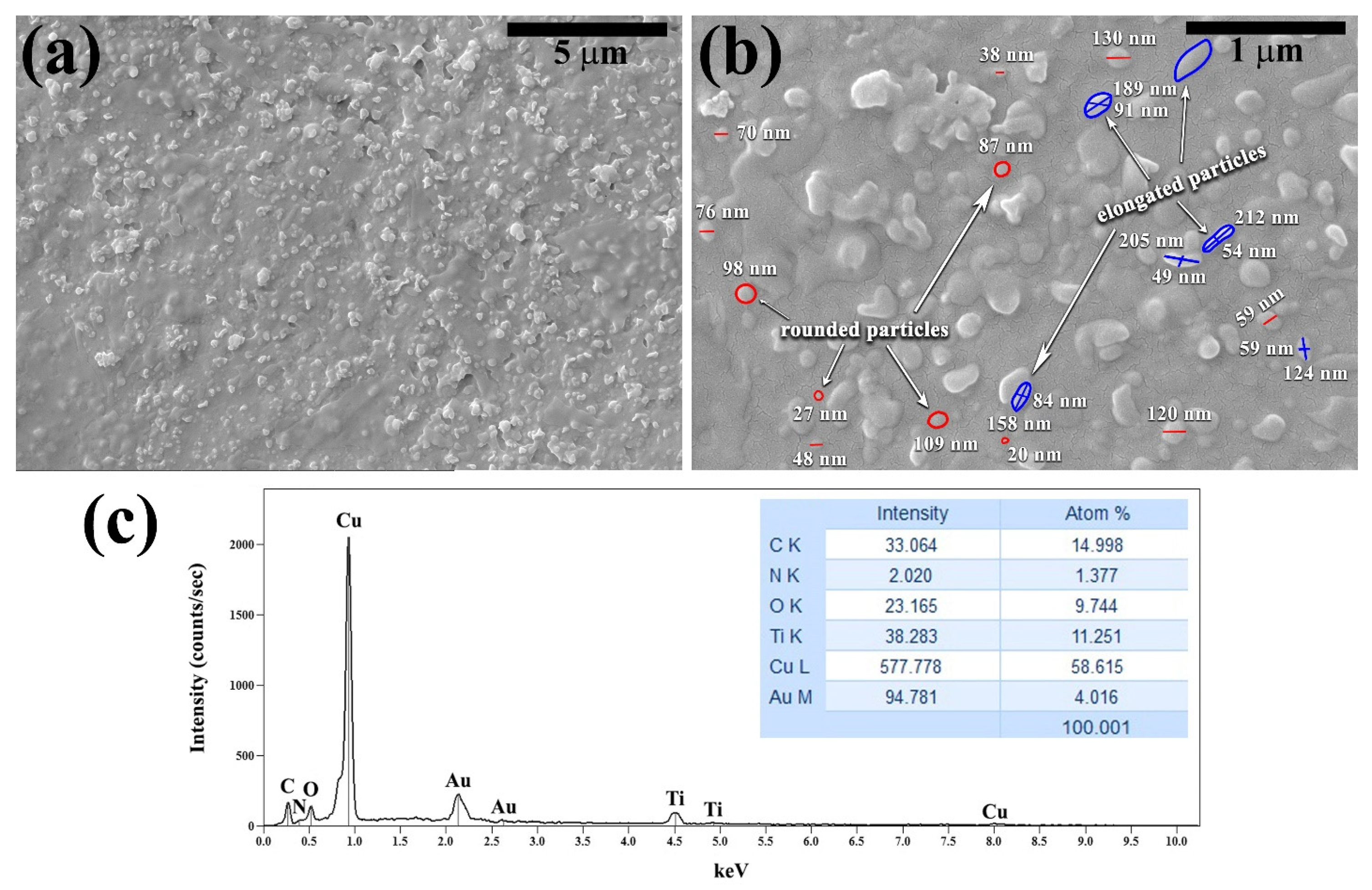
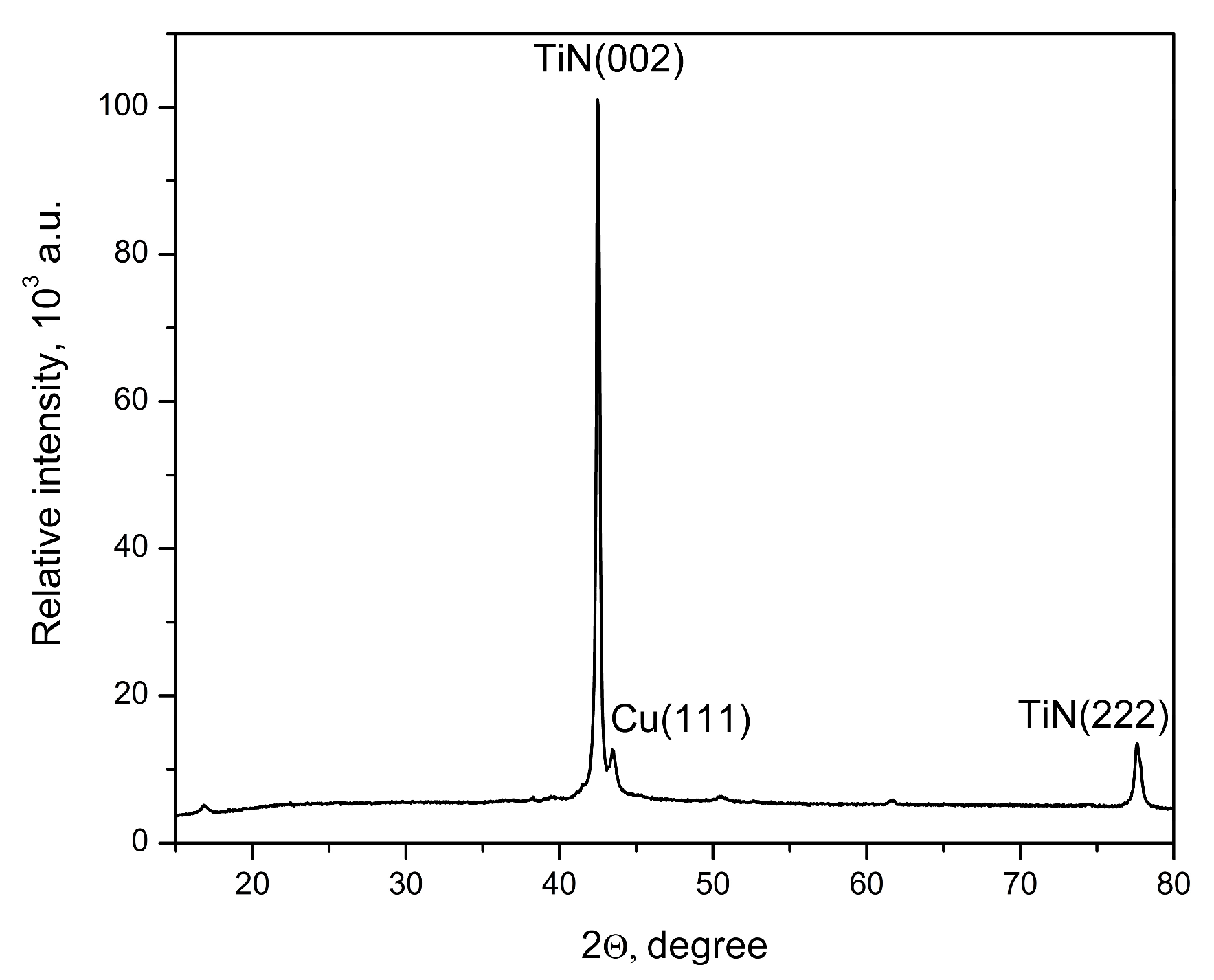
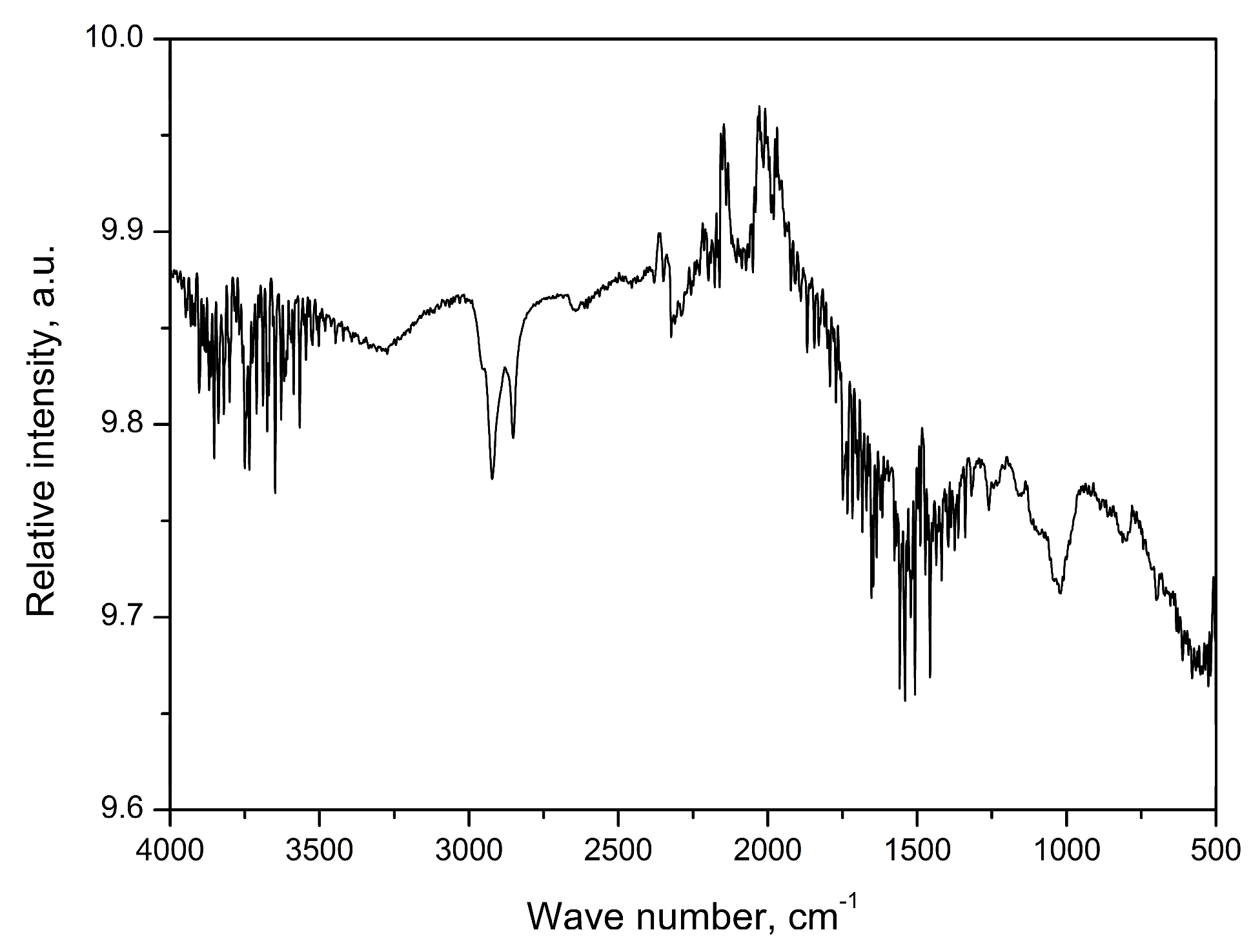
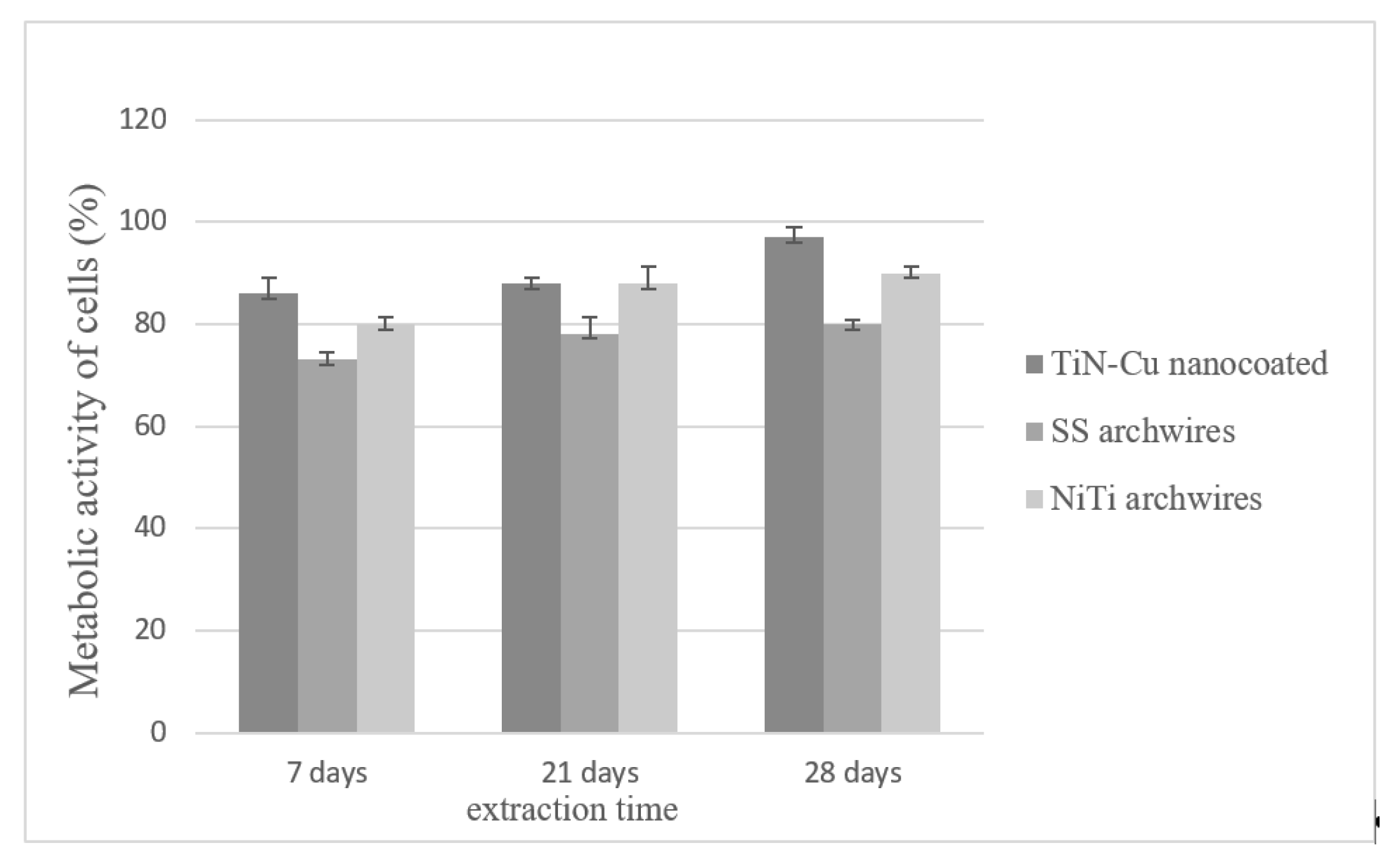
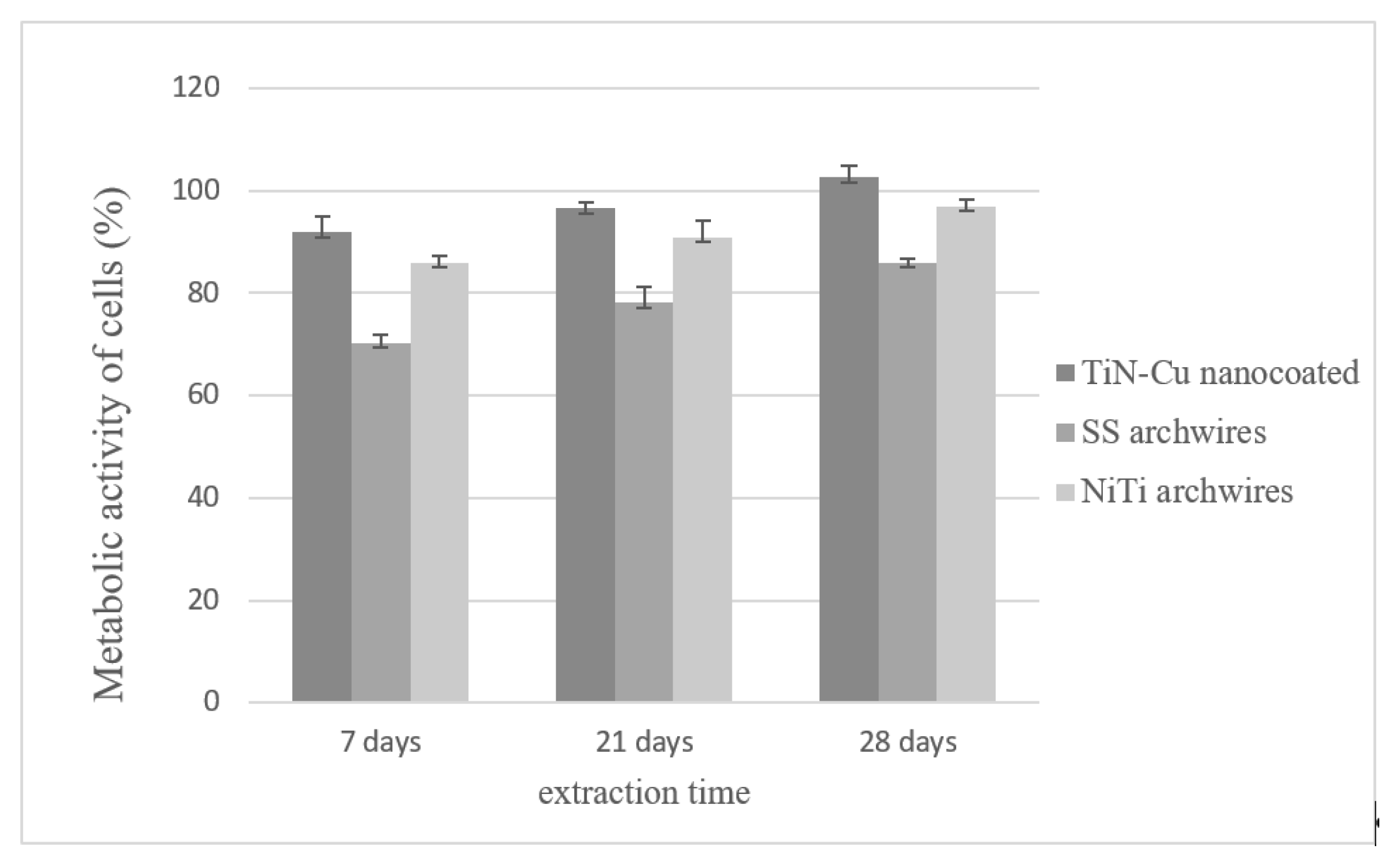
| Ion | TiN-Cu-Coated Archwire | NiTi Archwire | SS Archwire | ||||||
|---|---|---|---|---|---|---|---|---|---|
| 7 Days | 21 Days | 28 Days | 7 Days | 21 Days | 28 Days | 7 Days | 21 Days | 28 Days | |
| Ti water | 2.8 ± 0.2 | 3.8 ± 0.1 | 4.1 ± 0.1 | 3.1 ± 0.2 | 3.0 ± 0.1 | 3.1 ± 0.1 | 1.6 ± 0.1 | 1.8 ± 0.2 | 1.7 ± 0.2 |
| Ti acid | 929 ± 12 | 958 ± 20 | 963 ± 19 | 354 ± 9 | 1144 ± 23 | 1398 ± 31 | 6.9 ± 0.2 | 2.9 ± 0.1 | 7.4 ± 2.9 |
| Ni water | 6.1 ± 0.1 | 6.1 ± 0.1 | 1.7 ± 0.1 | 33.9 ± 0.1 | 21.0 ± 0.1 | 19.7 ± 0.2 | 3.5 ± 0.1 | 3.7 ± 0.3 | 3.7 ± 0.2 |
| Ni acid | 59.9 ± 0.8 | 1429 ± 29 | 1443 ± 21 | 555 ± 5 | 1917 ± 15 | 2129 ± 20 | 49 ± 2 | 75.7 ± 3 | 111 ± 2 |
| Cu water | 1210 ± 0.8 | 1010 ± 0.2 | 956 ± 0.4 | 49.8 ± 0.2 | 71.6 ± 0.8 | 119 ± 1.2 | 46.8 ± 0.5 | 30.3 ± 0.8 | 13 ± 1.2 |
| Cu acid | 1020 ± 1.2 | 961 ± 0.4 | 879 ± 0.7 | 59.3 ± 0.4 | 78.2 ± 0.2 | 128.1 ± 0.1 | 82.4 ± 0.2 | 40.1 ± 0.1 | 25.6 ± 1.0 |
| Cr water | <1 | <1 | <1 | <1 | <1 | <1 | <1 | <1 | <1 |
| Cr acid | 1.7 ± 0.2 | 2.0 ± 0.3 | 2.1 ± 0.1 | 2.5 ± 0.4 | 3.4 ± 0.1 | 3.8 ± 0.2 | 32.6 ± 1.5 | 41.8 ± 1.2 | 50.4 ± 1.8 |
| Streptococcus mutans | Streptococcus mitis | |||||
|---|---|---|---|---|---|---|
| TiN-Cu-Nanocoated Archwires | NiTi Archwires | SS Archwires | TiN-Cu-Nanocoated Archwires | NiTi Archwires | SS Archwires | |
| Log CFU ± SD | 4.19 ± 0.22 | 4.29 ± 0.24 | 5.87 ± 1.10 | 3.08 ± 0.99 | 3.75 ± 0.82 | 5.54 ± 0.60 |
Disclaimer/Publisher’s Note: The statements, opinions and data contained in all publications are solely those of the individual author(s) and contributor(s) and not of MDPI and/or the editor(s). MDPI and/or the editor(s) disclaim responsibility for any injury to people or property resulting from any ideas, methods, instructions or products referred to in the content. |
© 2023 by the authors. Licensee MDPI, Basel, Switzerland. This article is an open access article distributed under the terms and conditions of the Creative Commons Attribution (CC BY) license (https://creativecommons.org/licenses/by/4.0/).
Share and Cite
Ilić, B.; Petrović, B.; Marinković, J.; Miletić Vukajlović, J.; Stevanović, M.; Potočnik, J.; Jokanović, V. Investigation of Ion Release and Antibacterial Properties of TiN-Cu-Nanocoated Nitinol Archwires. Coatings 2023, 13, 1587. https://doi.org/10.3390/coatings13091587
Ilić B, Petrović B, Marinković J, Miletić Vukajlović J, Stevanović M, Potočnik J, Jokanović V. Investigation of Ion Release and Antibacterial Properties of TiN-Cu-Nanocoated Nitinol Archwires. Coatings. 2023; 13(9):1587. https://doi.org/10.3390/coatings13091587
Chicago/Turabian StyleIlić, Bojana, Božana Petrović, Jelena Marinković, Jadranka Miletić Vukajlović, Momir Stevanović, Jelena Potočnik, and Vukoman Jokanović. 2023. "Investigation of Ion Release and Antibacterial Properties of TiN-Cu-Nanocoated Nitinol Archwires" Coatings 13, no. 9: 1587. https://doi.org/10.3390/coatings13091587
APA StyleIlić, B., Petrović, B., Marinković, J., Miletić Vukajlović, J., Stevanović, M., Potočnik, J., & Jokanović, V. (2023). Investigation of Ion Release and Antibacterial Properties of TiN-Cu-Nanocoated Nitinol Archwires. Coatings, 13(9), 1587. https://doi.org/10.3390/coatings13091587







